The Beginning of Reflective Signs – (www.tapedealer.com)
The history of reflective elements on signage began with the creation of the Cataphote or glass cats eye by an inventor named Percy Shaw. The little glass cataphotes were used in the center of roadways, and also on signs themselves. Up until this time, signs were painted in different contrasting colors, but with no reflective qualities whatsoever. So often they were invisible at night when they needed to be seen the most. Percy Shaws invention changed that, and for the first time, you could actually see the word stop on a stop sign at night. In 1927 Percy Shaw applied for and was granted a patent for his invention. His Cataphotes became a big hit and sparked a race to find a better way to light up road signs at night.
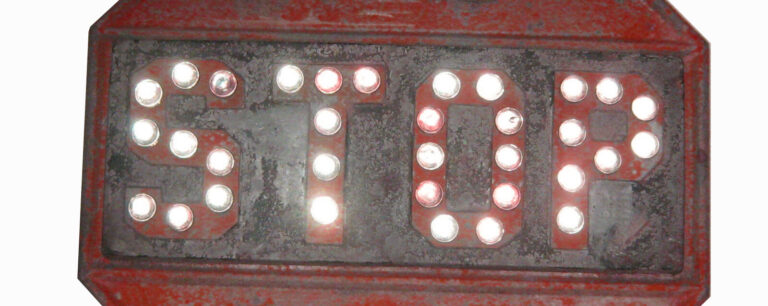
A little earlier, in 1914, Rudolph Potters began experimenting with ways of mass producing tiny perfectly round retro reflective spheres. These round glass spheres would reflect like a Cataphote, but would be much smaller, the size of a ball in the tip of a ball point pin. Also, these beads would not be used one at a time like Cataphotes. Instead they would be used in mass quantities to make large areas retro reflective. Mr. Potters invention was successful, and much later in 1941 he applied for and received a patent for the process and the equipment needed to produce glass beads. This invention is the pivotable discovery that ties early reflective signs that were primitive and used cataphotes, to modern day signs that use true retro reflectivity across the entire surface of the sign.
In the beginning, retro reflective micro beads were used in conjunction with a binder or paint to create reflective surfaces. Movie screens are one example, and road striping is another. Just like a Cataphote, light enters the glass beads, is bent, bounced, and returned to the source, wherever that may be. The spherical and parabolic shape of the bead is what makes this possible. So in contrast to the Cataphote, which covered maybe a square inch each, large areas could be made reflective by binding the beads with a coating and covering the surface. To work, all that is necessary is for the tops of the beads to be exposed so light can enter and exit. (Note – a fully encapsulated bead will not reflect since light cannot reach it) So when beads are on top of a surface, they make the surface retro reflective. This is important, because these applications are what led to further discoveries which are described below.
The Beginning of Modern Reflective Traffic Signs (From Road Stripes to Reflective Signs)
Before there were reflective signs, there were reflective road stripes. Glass beads from Potters were distributed on wet paint to make them reflective at night. At night, a stop sign could not be seen, however, the stop bar, if it had glass beads on it, could be.
The history of modern day reflective traffic signs began in 1937, when a 3m laborer was tasked with the job of creating a new method for making reflective center lines on roads in Minnesota. The goal was to make a tape that gave the same effect as the method at the time of dropping glass beads on wet paint. Basically a roll of road striping. The laborers name was Harry Heltzer. In any event, Heltzer accepted the job of developing this new product and set about trying to determine how to make it work.
A highway official suggested that he embed glass beads into a stripe, giving him the idea of a glass bead based reflective tape for pavement. His first mission was to source glass beads that were retro reflective and small enough to be imbedded into a carrier such as a tape. Mr. Heltzer used double-sided tape with an adhesive top and bottom and embedded the beads on one side. The other side would be used to adhere the stripe to a road. What Heltzer created did in fact reflect, and did create a reflective stripe on pavement. The issue however, was keeping the stripe adhered to a cold Minnesota roadway and keeping it reflective for a long period of time. Basically, for the product to be commercially viable, it had to work as well as reflective paint. So the invention worked, but not well enough to be used commercially. But all was not lost, while this first attempt at making reflective road striping on a roll did not pan out, it did lead to another amazing invention that changed night time safety forever.
(Note – 3m did not give up on reflective road striping and later on in 1974, patented a product that we now know as Stamark. Reflective road stripes on a roll.)
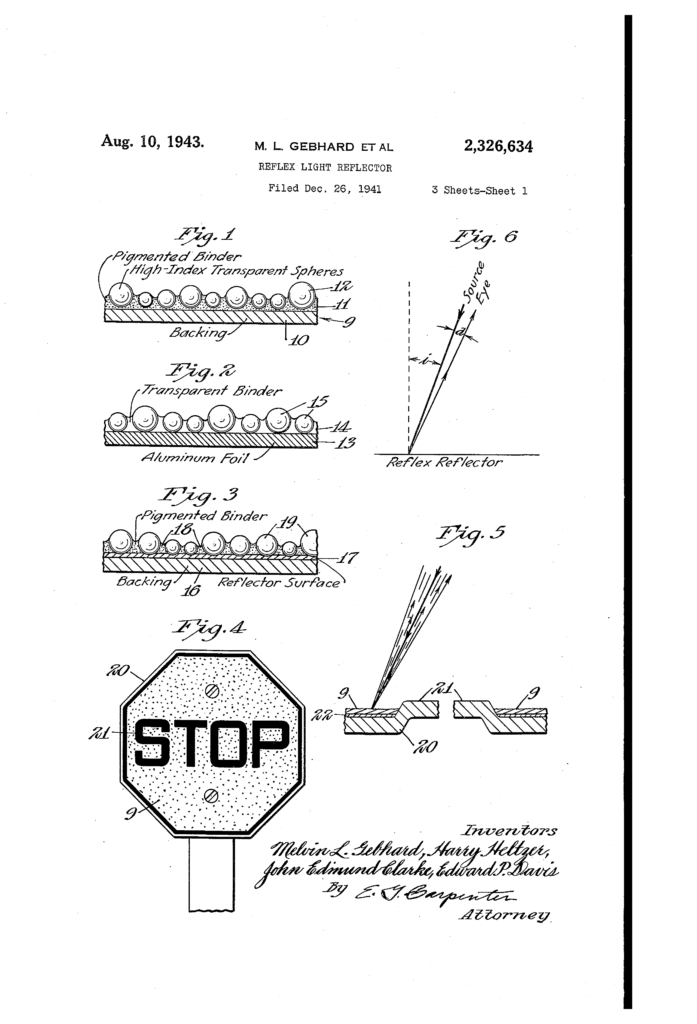
Harry Heltzer and his team, with the knowledge and experience gained from reflective road striping in hand, began development of a new invention that would soon evolve into a product known as engineer grade reflective sign sheeting. A product used to this day. The idea was to take the road stripe idea that did not work so well, and transfer it to a sign where road wear was not so much of an issue. In any event, the invention began as a fairly crude product that was functional, but with drawbacks. Three of which were, wet reflectivity, dirt and grime on the beads, and an overall reflectivity deficit.
In the first iterations of the new product, glass beads were simply embedded into the surface of a film and left exposed so they could reflect light. This was much like the road striping product where the beads were exposed on top of double stick tape. The film was then placed on a sign. The reflective sheeting worked somewhat, however, when dirt got between the beads, or when it rained, the beads stopped returning light in amounts sufficient to see. And overall, even without these issues, the brightness was disappointing.
So in summary, in early iterations, reflectivity achieved was low and in rain or when the sheeting accumulated dirt and grime, it was even lower. This experimentation was a good beginning, but further improvements were definitely needed before it was commercially viable. So Heltzer and his team went back to the drawing board so to speak, and worked on solving these issues. They needed the tape to be brighter, it needed to reflect in all weather conditions, and lastly, the beads needed a way to stay clean.
Note – A single glass bead will reflect by itself on pretty much any surface. When applied in a large area, the apparent reflectivity greatly increases since all the beads are returning light together. When on a light colored background they do even better. But on a mirrored background, like metallic silver, they reflect the best. And this is what the team discovered.
To increase the return of light, 3m created a base layer or background on a film that was a silver color like what what you would find on the back of a mirror. Perfectly round glass beads were applied to this silver surface with half the bead embedded and half exposed. In essence, the silver backing transformed the back of the glass bead into a mirror. And not just any mirror, because the shape of the bead also provided for the return of light back to the source. So what was invented was a retro reflective glass bead, with a mirror finish on the back only. An innovation that increased reflectivity substantially. This took care of the issue with brightness and offset the other issues as well. But more work needed to be done.
After brightening up the film, the issue of not reflecting when dirty or wet needed to be addressed. The beads needed to be protected, while still being allowed to reflect. To protect the beads, a very thin clear layer of polymer was applied over the top of the film that sealed the beads without hindering reflectivity. This was tricky, but they figured it out. The clear layer kept the beads from accumulating dirt and also made the tape visible even in rain. (Note – by tinting the top coat, it was discovered that different colors could be created)
In 1939, 3m introduced what was known then and today as “engineer grade” reflective sheeting. The invention was filed with the patent office in 1941, and officially patented in 1943. The patent was titled, “Reflex Light Reflector“. The new product was first used in trials in Minneapolis and then in the UK. After a short time, and plenty of marketing, reflective signs made with 3m’s new product took off.
Of note is that the film was CAD or plotter cuttable, so creating letters was an easy task and very convenient for the industry. Engineer grade films by 3m could be used for sign backgrounds and lettered on top with non reflective material for contrast. Or letters could be cut from the material itself so that the letters or numbers were reflective on a non reflective background. The former is most popular, but either way works. For over two decades, 3m’s engineer grade films, and later their high intensity sheeting, dominated the industry. The inventions went through many improvements, and other similar reflective films were also created using the same glass bead technology. In any event, across the country, and around the world, signs began to light up at night as this new and innovative film was adopted.
The Introduction of Micro Prismatic Sign Sheeting
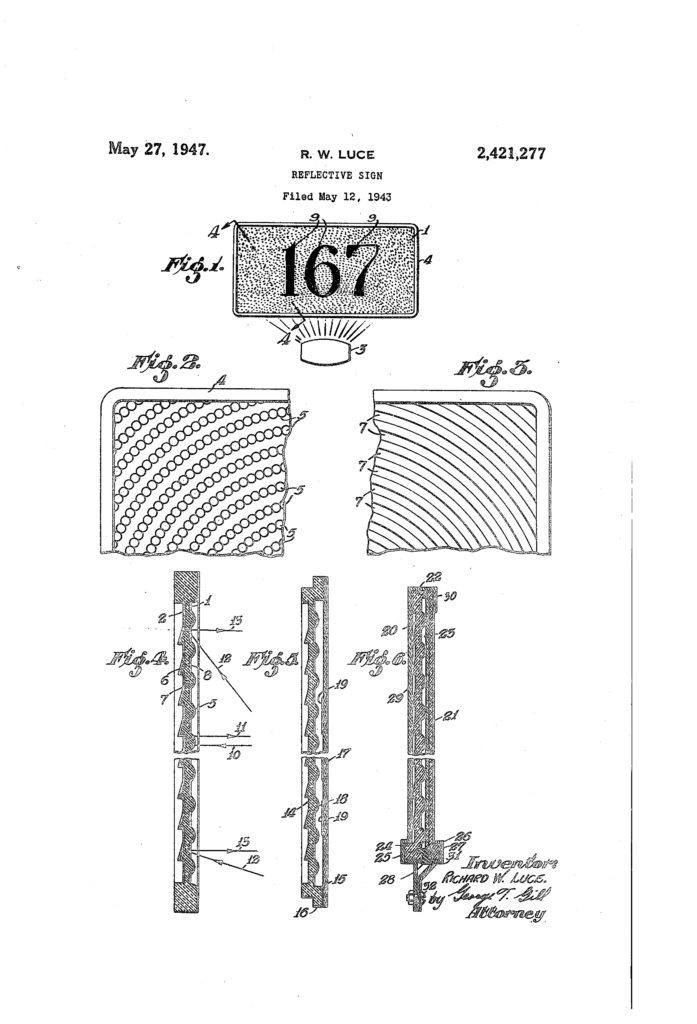
3m was not the only inventor or company pursuing patents in the field of retro reflectivity. All over the world, inventors were experimenting with retro reflective devices using glass beads, as well as prisms made of glass or plastic. In fact, 3 months prior to 3m receiving their patent for engineer grade tape, in late 1941, an inventor named Richard Luce of South Port Connecticut, filed for a patent on a retro reflective device that did not use glass beads. Instead, he used molded plastic reflectors that emulated what a glass bead could do, only with angled prisms. Think of your cars rear tail light reflectors, or the reflector on your bike and you’ll have an idea of what Mr. Luce was creating. In any event, this was just the beginning of his experimentation into man made prisms and reflectors. Luce’s patent was granted in 1947 and he continued to innovate and invent new and better ways to reflect light. He later formed a company called Luce Reflexite in the state of Connecticut.
In 1963, brothers Hugh and Bill Rowland, who were also experimenting with prisms and retro reflective devices, bought the rights to develop a new retro-reflective technology from Luce Reflexite. You see, the Rowland brothers were working on something very innovative that would also change the world of night time safety, just as much as 3m’s reflective tape had.
Note – Bill and Hugh Rowland are two Yale Educated engineers and also brothers. Reflexite was the 19th company they had formed. After turning down an offer from 3m to buy the small company, the Rowland brothers decided to sell it over time to the employees using an ESOP. Orafol merged with Reflexite in 2011. A transaction that netted the employee stock holders 40 million dollars.
In any event, after securing all the rights , the Reflexite company was formed. They quickly created and patented the worlds first micro-prismatic sheeting or tape, a product that is as much as 20 times brighter than engineer grade films. This meant that signs that were formerly visible at say 300 feet away, could now be seen from over 3000 feet away. So as traffic moved faster, this was a huge step forward in night time safety on the road.
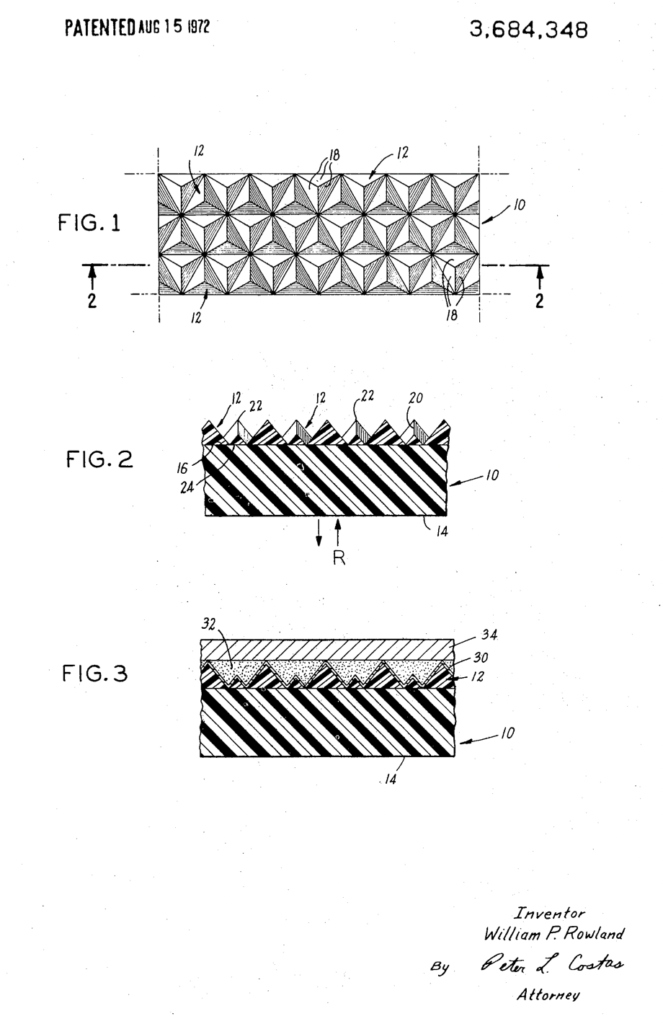
Reflexite’s first patent was labeled “Retro Reflective Material“, and was filed for in September of 1970, and was granted in 1972. This new invention would revolutionize the highway sign industry as well as vehicle conspicuity. Their new product was not only much brighter, it was also incredibly tough and rugged. This made it perfect for both sign applications which were static, and also vehicle conspicuity applications which were much more dynamic. In other words, Reflexite’s new retro reflective film was bright and tough, unlike anything the industry had ever seen.
Reflexite patented many more retro reflective films, with improvement in reflectivity, vividness, daytime visibility, and adhesion. Because 3m still had the sign sheeting market locked up tight, Reflexite focused on vehicle conspicuity and quickly became the number one manufacturer of conspicuity tapes in the world. Their product was bright, thin, CAD cuttable, and did not delaminate due to it’s single layer design.
3m, seeing what Reflexite had invented, waited until the patent expired, and introduced their Diamond Grade reflective sign sheeting. They applied for a patent for their DG sheeting in 1993, and received it in 1996. Because Reflexite had focused on vehicle conspicuity, and because of 3m’s marketing power, they were able to get the sign industry to switch over to their new prismatic films fairly easily. So although Reflexite sheeting never replaced the sheeting used on signs throughout the world, their invention made it possible.
Of note is the fact that after decades in the retro reflective sheeting industry, around 2010, Reflexite created a line of retro reflective films made just for signs. This was just prior to their merger with Orafol. The product was called High Intensity Prismatic or Oralite 5900. It is a vivid air back prismatic that exceeds all ASTM D4956 Specifications for Type 4 sign sheeting. They followed this product up with their 5930 and 5935 High Intensity Prismatic work zone reflective films, also Type 4 rated tapes. About a year later, Orafol in Europe began offering Type 9 Wide Observation Sheeting, and Type 11 Brilliant Grade Sheeting. Those two products, along with the 5900 series, are now marketed in the United States.
The timing for the addition of sign sheeting to Orafol’s extensive line of reflective films is appropriate, given that sign regulations have been changing and brighter films are now being mandated all over the country. As an example, the MUTCD eliminated engineer grade type 1 as an option for street signs and for all practical purposes, increased reflectivity requirements to a Type 4 Prismatic sheeting or better. Technically a Type 2 or Type 3 film can be used for certain applications, however, it is not likely that very many municipalities or road agencies will use older technology glass bead sheeting such as type 2 or 3 for new signs.
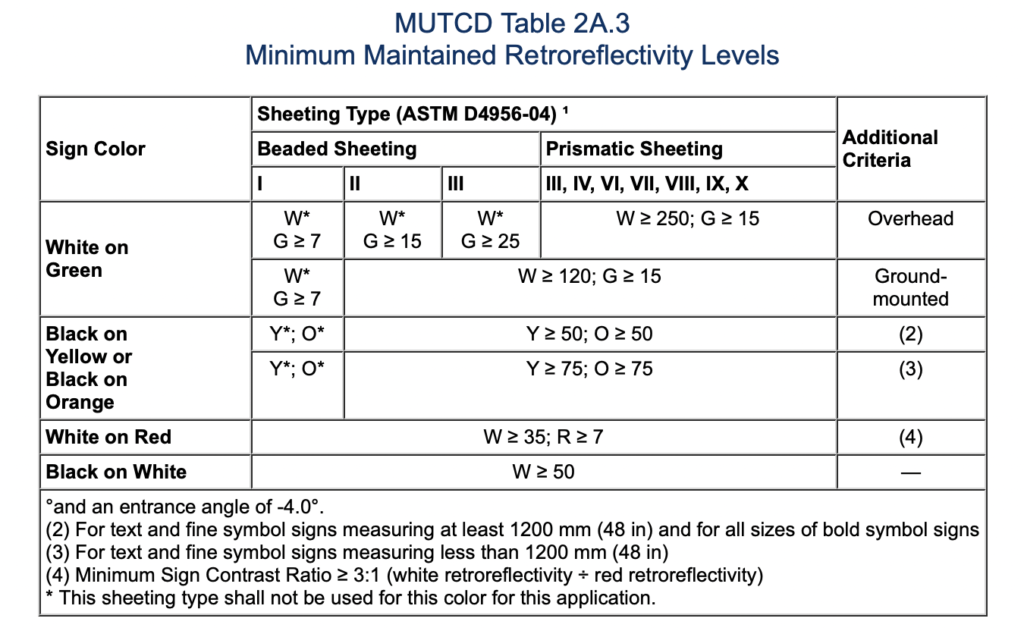
As it stands right now, 3m is the leader in sign sheeting with their Diamond Grade films. However, they are not without competition. Avery, Nikkalite, and of course Oralite are also in the race and are actively competing for their part of a nearly 3.5 billion dollar market for sign sheeting alone. The key will be in the development and marketing of new Type 9 and Type 11 retro reflective films.